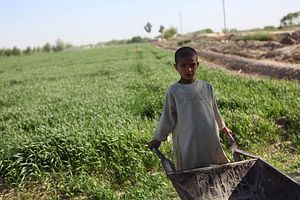Afghan farmers struggle to gain access to regional markets as insecurity, poor market conditions, lack of technical support from the government, farmers’ displacement, and cheap food imports from neighboring countries continue to threaten the formation of a sustainable agriculture-based economy.
Over the past decades, particularly since the Soviet invasion, followed by the infighting that lasted for a decade, Afghanistan’s economic structure has been dismantled. The country’s agriculture sector, once considered the core of its economic prosperity became a major victim of the ongoing tragedies. The various components of the industry, including farmers, supporting institutions, and the essential infrastructure, all received major blows. Irrigation systems, albeit traditional ones, have been heavily disrupted. One should not forget the millions of displaced farmers, accompanied by a never-ending brain drain and outflow of expertise. The result has been devastating as presently Afghanistan’s agriculture sector is ranked as one of the least developed among its neighbors.
With approximately 70 percent of the population living in rural areas, primarily involved in agricultural activities, Afghanistan’s agriculture sector, according to the World Bank, contributes one-fourth to one-third of the country’s $20 billion GDP (based on 2012 estimates), depending on annual output. Arable land is limited to only 12 percent of the country’s 65 million hectares due to insecurity, land disputes, and landmines left from the Soviet invasion and infighting, creating a major challenge for farmers returning home to resume agricultural activities. Meanwhile, only 40 percent of the entire agricultural land in the country is irrigated, which is in turn causing agricultural production growth rates to stumble.
The sector has witnessed a slight improvement since 2002, in the post-Taliban era. Minor investments in this sector provided an opportunity for a limited number of farmers to resume farming and add value to the national economy. The Afghanistan Investment Support Agency (AISA) estimates the total investment in the agriculture sector (including crop and fruit production and livestock) to be less than $200 million out of a total of $8.9 billion fixed business investment since 2001, while the services sector received $4.2 billion, the industries sector $3.3 billion, and the construction sector received only $1.2 billion in private investment.
A bulk of that $200 million has been invested in major cities, including Kabul, Herat, Balkh, Nangarhar, and Kandahar, where security is relatively stable and the required infrastructure is in place. The rest of the country has not received any major agricultural investment, which counts as one of the main reasons behind the low agricultural production growth rate. This is in turn creating another superior challenge for the government and the private sector to tackle – the drastic increase in poppy cultivation in areas where agriculture development receives the least attention.
The Afghanistan National Development Strategy (ANDS) considers irrigation and effective water management as one of the highly significant components of social and economic development, and considers this as a vital tenet in creating an independent and sustainable agro-economy. Despite all these efforts, irrigation facilities across the country lag far behind. With 1.8 million hectares of land under irrigation, only 10 percent gets water from engineered systems and the remaining through traditional irrigation methods. Approximately 6 percent of arable land is still to come under the government irrigation plans. An effective irrigation and water management policy with realistic goals should be in place if the irrigation tenets of the national development strategy are to ever come close to realization.
The effects of the free market economy adopted by the government since 2001 have had enormous adverse effects on farmers residing in rural areas. The primary requirement for any economic regime to adopt a market economy is to have some degree of political, economic, and social institutions in place. Afghanistan’s local farmers, with the little access they have gained over the past decade to the few regional markets, have paid heavily to keep astride with the competition emanating from neighboring countries, Pakistan and Iran in particular. Cheap food imports from Iran and Pakistan have strangled local farmers, many of whom have heavily failed their search for markets. The logic of low tariffs on imported goods may have some positive impacts on regional trade relations, but will continue to suppress farmers inside the country, resulting in an economy ever-dependent on neighboring countries.
Investing in local farmers and in agricultural development will eventually position Afghanistan as a regional agricultural hub. Upgrading the content and the capacity of the current institutions offering agricultural development programs to youth and farmers will prove vital in the future. Attracting regional investment, in particular from India and members of the Gulf Cooperation Council, who strive for regional markets to ensure their food security, will not only serve as an internal development tool, it will also enhance regional relations to a greater extent. The Afghan government opening the first agricultural university in the country, the Afghan National Agricultural Sciences and Technology University in Kandahar, with the backing of India, is a prime example of a strategic approach to sustainable development of agriculture in the country. Neglected Afghan local farmers, if provided with practical support and protection by the Afghan government, will eventually become regional unique selling points for the country.
Mohammad Abed Shirzai works as a Strategic Communications expert for a leading international firm. My interest and research focus consists of the nexus of entrepreneurship, education and development in Afghanistan and the GCC countries. He is also pursuing a Master’s Degree in Public Policy in Hamad Bin Khalifa University in Qatar.
































